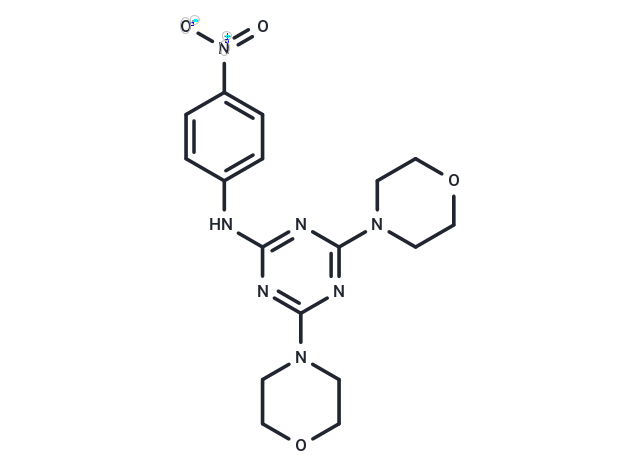Shopping Cart
- Remove All
 Your shopping cart is currently empty
Your shopping cart is currently empty


| Pack Size | Price | Availability | Quantity |
|---|---|---|---|
| 5 mg | $43 | In Stock | |
| 10 mg | $61 | In Stock | |
| 25 mg | $113 | In Stock | |
| 50 mg | $196 | In Stock | |
| 100 mg | $363 | In Stock | |
| 200 mg | $535 | In Stock | |
| 1 mL x 10 mM (in DMSO) | $48 | In Stock |
| Description | MHY1485 is an mTOR activator that is cell-permeable. MHY1485 inhibits autophagosome and lysosome fusion, leading to accumulation of LC3II proteins and increased autophagosomes, thereby inhibiting cellular autophagy. |
| In vitro | METHODS: MDA-MB-231, BT-20, MDA-MB-468 cells and T cells were co-cultured and treated with Atezolizumab (50-100 µg/mL) for 4-24 h. T cell-mediated cytotoxicity assay was performed. RESULTS: Atezolizumab significantly enhanced T cell-mediated cytotoxicity of MDA-MB-231 cells in a dose-dependent manner, with 100 µg/mL concentration of Atezolizumab showing significant efficacy at 4 and 24 h incubation. Similar results were obtained with BT-20. No Atezolizumab-induced T cell-mediated cytotoxicity was observed in PD-L1- MDA-MB-468 cells compared to MDA-MB-231 and BT-20 cells. [1] METHODS: MDA-MB-231 cells were treated with Atezolizumab (0.5 µg/mL) for 24 h. Surface expression of PD-L1 was detected by flow cytometry. RESULTS: Almost all MDA-MB-231 cells were positive for PD-L1, but detection of PD-L1 epitopes was blocked by the specific antibody Atezolizumab after 24 h treatment. [2] |
| In vivo | METHODS: To detect in vivo antitumor activity, Atezolizumab (10 mg/kg) and Bevacizumab (5 mg/kg) were intraperitoneally injected into BALB/C nude mice bearing A2780cis xenografts every two days for three weeks. RESULTS: In vivo treatment with Atezolizumab or Bevacizumab induced significant antitumor effects and significantly inhibited tumor growth. Dual blockade with Atezolizumab and Bevacizumab significantly inhibited tumor growth compared to each treatment. [3] |
| Kinase Assay | Ovaries from mice at day10 of age are treated with 10 μM MHY1485 for 3h and proteins are extracted using M-PER Mammalian Protein Extraction Reagent containing a protease inhibitor cocktail. Protein concentrations in supernatants are determined by the bicinchoninic acid method. Equal amounts of protein lysates are loaded on 4-12% NuPAGE Bis-Tris gels in MOPS buffer and transferred to 0.45 μM pore nitrocellulose membranes[2]. |
| Cell Research | MHY1485 is dissolved in DMSO and then diluted with appropriate media[3]. MC3T3-E1 cells are maintained in Dulbecco's modified Eagle's medium (DMEM) supplemented with 10% fetal bovine serum (FBS), 100 U/mL penicillin and 100 mg/mL streptomycin at 37°C in a humidified atmosphere of 5% CO2. Having reached 70% confluence, the culture medium is switched to commercial osteogenic differentiation medium. MC3T3-E1 cells are cultured in the osteogenic differentiation medium for 14 days, following by culture in DMEM supplemented with varying concentrations of liraglutide (catalog no. HY-P0014; MedChem Express) for a further 14 days. MC3T3-E1 cells treated with 4 nM liraglutide are cultured in the presence or absence of Compound C or MHY1485. MC3T3-E1 cells maintained in DMEM for 28 days in the absence of any treatment are used as the negative control (NC); cells cultured in commercial osteogenic differentiation medium for 14 days and in DMEM without liraglutide for an additional 14 days are used as the positive control (PC)[3]. |
| Molecular Weight | 387.39 |
| Formula | C17H21N7O4 |
| Cas No. | 326914-06-1 |
| Storage | Powder: -20°C for 3 years | In solvent: -80°C for 1 year | Shipping with blue ice. | ||||||||||||||||||||
| Solubility Information | Ethanol: < 1 mg/mL (insoluble or slightly soluble) DMSO: 3.87 mg/mL (10 mM), Sonication is recommended. H2O: < 1 mg/mL (insoluble or slightly soluble) | ||||||||||||||||||||
Solution Preparation Table | |||||||||||||||||||||
DMSO
| |||||||||||||||||||||

Copyright © 2015-2024 TargetMol Chemicals Inc. All Rights Reserved.